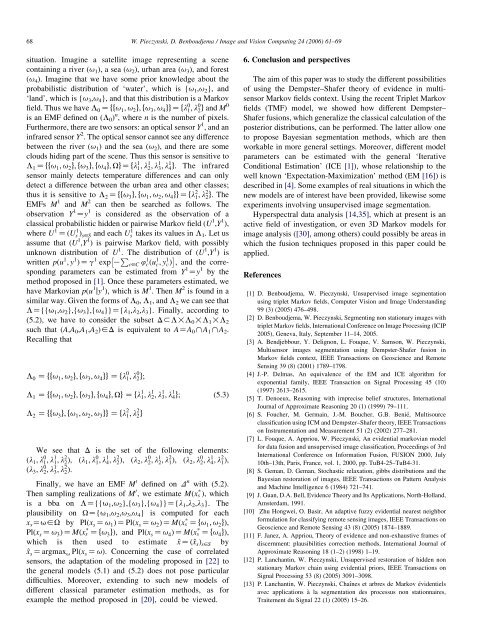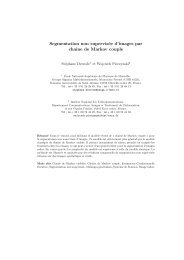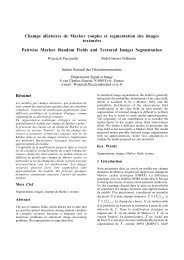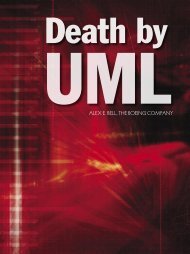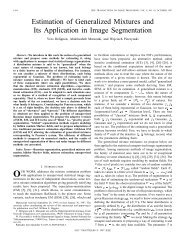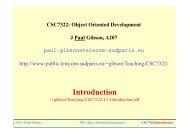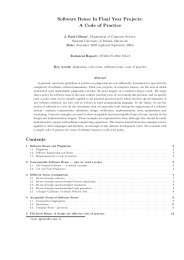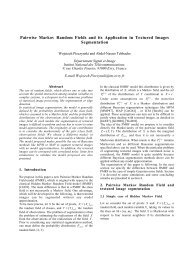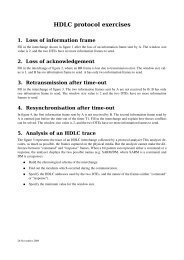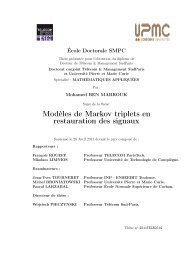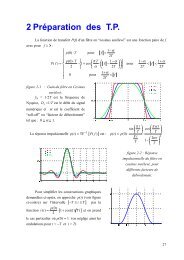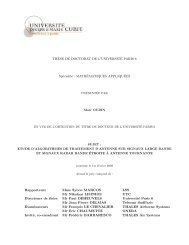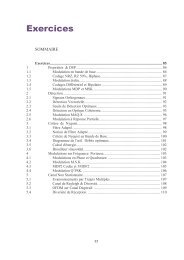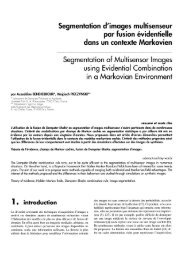Multisensor triplet Markov fields and theory of evidence
Multisensor triplet Markov fields and theory of evidence
Multisensor triplet Markov fields and theory of evidence
Create successful ePaper yourself
Turn your PDF publications into a flip-book with our unique Google optimized e-Paper software.
68<br />
W. Pieczynski, D. Benboudjema / Image <strong>and</strong> Vision Computing 24 (2006) 61–69<br />
situation. Imagine a satellite image representing a scene<br />
containing a river (u 1 ), a sea (u 2 ), urban area (u 3 ), <strong>and</strong> forest<br />
(u 4 ). Imagine that we have some prior knowledge about the<br />
probabilistic distribution <strong>of</strong> ‘water’, which is {u 1 ,u 2 }, <strong>and</strong><br />
‘l<strong>and</strong>’, which is {u 3 ,u 4 }, <strong>and</strong> that this distribution is a <strong>Markov</strong><br />
field. Thus we have L 0 Zffu 1 ; u 2 g; fu 3 ; u 4 ggZfl 0 1; l 0 2g <strong>and</strong> M 0<br />
is an EMF defined on (L 0 ) n , where n is the number <strong>of</strong> pixels.<br />
Furthermore, there are two sensors: an optical sensor Y 1 , <strong>and</strong> an<br />
infrared sensor Y 2 . The optical sensor cannot see any difference<br />
between the river (u 1 ) <strong>and</strong> the sea (u 2 ), <strong>and</strong> there are some<br />
clouds hiding part <strong>of</strong> the scene. Thus this sensor is sensitive to<br />
L 1 Zffu 1 ; u 2 g; fu 3 g; fu 4 g; UgZfl 1 1; l 1 2; l 1 3; l 1 4g. The infrared<br />
sensor mainly detects temperature differences <strong>and</strong> can only<br />
detect a difference between the urban area <strong>and</strong> other classes;<br />
thus it is sensitive to L 2 Zffu 3 g; fu 1 ; u 2 ; u 4 ggZfl 2 1; l 2 2g. The<br />
EMFs M 1 <strong>and</strong> M 2 can then be searched as follows. The<br />
observation Y 1 Zy 1 is considered as the observation <strong>of</strong> a<br />
classical probabilistic hidden or pairwise <strong>Markov</strong> field (U 1 ,Y 1 ),<br />
where U 1 ZðUs 1 Þ s2S <strong>and</strong> each Us 1 takes its values in L 1 . Let us<br />
assume that (U 1 ,Y 1 ) is pairwise <strong>Markov</strong> field, with possibly<br />
unknown distribution <strong>of</strong> U 1 . The distribution <strong>of</strong> (U 1 ,Y 1 ) is<br />
written pðu 1 ; y 1 ÞZg 1 exp K P <br />
c2C 4 1 cðu 1 c; y 1 cÞ , <strong>and</strong> the corresponding<br />
parameters can be estimated from Y 1 Zy 1 by the<br />
method proposed in [1]. Once these parameters estimated, we<br />
have <strong>Markov</strong>ian p(u 1 jy 1 ), which is M 1 . Then M 2 is found in a<br />
similar way. Given the forms <strong>of</strong> L 0 , L 1 , <strong>and</strong> L 2 we can see that<br />
LZ{{u 1 ,u 2 },{u 3 },{u 4 }}Z{l 1 ,l 2 ,l 3 }. Finally, according to<br />
(5.2), we have to consider the subset D3L!L 0 !L 1 !L 2<br />
such that (A,A 0 ,A 1 ,A 2 )2D is equivalent to AZA 0 hA 1 hA 2 .<br />
Recalling that<br />
L 0 Z ffu 1 ; u 2 g; fu 3 ; u 4 gg Z fl 0 1; l 0 2g;<br />
L 1 Z ffu 1 ; u 2 g; fu 3 g; fu 4 g; Ug Z fl 1 1; l 1 2; l 1 3; l 1 4g;<br />
L 2 Z ffu 3 g; fu 1 ; u 2 ; u 3 gg Z fl 2 1; l 2 2g<br />
(5.3)<br />
We see that D is the set <strong>of</strong> the following elements:<br />
ðl 1 ; l 0 1; l 1 1; l 2 2Þ, ðl 1 ; l 0 1; l 1 4; l 2 2Þ, ðl 2 ; l 0 2; l 1 2; l 2 1Þ, ðl 2 ; l 0 2; l 1 4; l 2 1Þ,<br />
ðl 3 ; l 0 2; l 1 3; l 2 2Þ.<br />
Finally, we have an EMF M 0 defined on D n with (5.2).<br />
Then sampling realizations <strong>of</strong> M 0 , we estimate Mðx s * Þ, which<br />
is a bba on LZ{{u 1 ,u 2 },{u 3 },{u 4 }}Z{l 1 ,l 2 ,l 3 }. The<br />
plausibility on UZ{u 1 ,u 2 ,u 3 ,u 4 } is computed for each<br />
x s Zu2U by Plðx s Zu 1 ÞZPlðx s Zu 2 ÞZMðx s * Zfu 1 ; u 2 gÞ,<br />
Plðx s Zu 3 ÞZMðx s * Zfu 3 gÞ, <strong>and</strong> Plðx s Zu 4 ÞZMðx s * Zfu 4 gÞ,<br />
which is then used to estimate ^xZð^x s Þ s2S by<br />
^x s Zargmax u Plðx s ZuÞ. Concerning the case <strong>of</strong> correlated<br />
sensors, the adaptation <strong>of</strong> the modeling proposed in [22] to<br />
the general models (5.1) <strong>and</strong> (5.2) does not pose particular<br />
difficulties. Moreover, extending to such new models <strong>of</strong><br />
different classical parameter estimation methods, as for<br />
example the method proposed in [20], could be viewed.<br />
6. Conclusion <strong>and</strong> perspectives<br />
The aim <strong>of</strong> this paper was to study the different possibilities<br />
<strong>of</strong> using the Dempster–Shafer <strong>theory</strong> <strong>of</strong> <strong>evidence</strong> in multisensor<br />
<strong>Markov</strong> <strong>fields</strong> context. Using the recent Triplet <strong>Markov</strong><br />
<strong>fields</strong> (TMF) model, we showed how different Dempster–<br />
Shafer fusions, which generalize the classical calculation <strong>of</strong> the<br />
posterior distributions, can be performed. The latter allow one<br />
to propose Bayesian segmentation methods, which are then<br />
workable in more general settings. Moreover, different model<br />
parameters can be estimated with the general ‘Iterative<br />
Conditional Estimation’ (ICE [1]), whose relationship to the<br />
well known ‘Expectation-Maximization’ method (EM [16]) is<br />
described in [4]. Some examples <strong>of</strong> real situations in which the<br />
new models are <strong>of</strong> interest have been provided, likewise some<br />
experiments involving unsupervised image segmentation.<br />
Hyperspectral data analysis [14,35], which at present is an<br />
active field <strong>of</strong> investigation, or even 3D <strong>Markov</strong> models for<br />
image analysis ([30], among others) could possibly be areas in<br />
which the fusion techniques proposed in this paper could be<br />
applied.<br />
References<br />
[1] D. Benboudjema, W. Pieczynski, Unsupervised image segmentation<br />
using <strong>triplet</strong> <strong>Markov</strong> <strong>fields</strong>, Computer Vision <strong>and</strong> Image Underst<strong>and</strong>ing<br />
99 (3) (2005) 476–498.<br />
[2] D. Benboudjema, W. Pieczynski, Segmenting non stationary images with<br />
<strong>triplet</strong> <strong>Markov</strong> <strong>fields</strong>, International Conference on Image Processing (ICIP<br />
2005), Geneva, Italy, September 11–14, 2005.<br />
[3] A. Bendjebbour, Y. Delignon, L. Fouque, V. Samson, W. Pieczynski,<br />
<strong>Multisensor</strong> images segmentation using Dempster-Shafer fusion in<br />
<strong>Markov</strong> <strong>fields</strong> context, IEEE Transactions on Geoscience <strong>and</strong> Remote<br />
Sensing 39 (8) (2001) 1789–1798.<br />
[4] J.-P. Delmas, An equivalence <strong>of</strong> the EM <strong>and</strong> ICE algorithm for<br />
exponential family, IEEE Transaction on Signal Processing 45 (10)<br />
(1997) 2613–2615.<br />
[5] T. Denoeux, Reasoning with imprecise belief structures, International<br />
Journal <strong>of</strong> Approximate Reasoning 20 (1) (1999) 79–111.<br />
[6] S. Foucher, M. Germain, J.-M. Boucher, G.B. Benié, Multisource<br />
classification using ICM <strong>and</strong> Dempster–Shafer <strong>theory</strong>, IEEE Transactions<br />
on Instrumentation <strong>and</strong> Measurement 51 (2) (2002) 277–281.<br />
[7] L. Fouque, A. Appriou, W. Pieczynski, An evidential markovian model<br />
for data fusion <strong>and</strong> unsupervised image classification, Proceedings <strong>of</strong> 3rd<br />
International Conference on Information Fusion, FUSION 2000, July<br />
10th–13th, Paris, France, vol. 1, 2000, pp. TuB4-25–TuB4-31.<br />
[8] S. Geman, D. Geman, Stochastic relaxation, gibbs distributions <strong>and</strong> the<br />
Bayesian restoration <strong>of</strong> images, IEEE Transactions on Pattern Analysis<br />
<strong>and</strong> Machine Intelligence 6 (1984) 721–741.<br />
[9] J. Guan, D.A. Bell, Evidence Theory <strong>and</strong> Its Applications, North-Holl<strong>and</strong>,<br />
Amsterdam, 1991.<br />
[10] Zhu Hongwei, O. Basir, An adaptive fuzzy evidential nearest neighbor<br />
formulation for classifying remote sensing images, IEEE Transactions on<br />
Geoscience <strong>and</strong> Remote Sensing 43 (8) (2005) 1874–1889.<br />
[11] F. Janez, A. Appriou, Theory <strong>of</strong> <strong>evidence</strong> <strong>and</strong> non-exhaustive frames <strong>of</strong><br />
discernment: plausibilities correction methods, International Journal <strong>of</strong><br />
Approximate Reasoning 18 (1–2) (1998) 1–19.<br />
[12] P. Lanchantin, W. Pieczynski, Unsupervised restoration <strong>of</strong> hidden non<br />
stationary <strong>Markov</strong> chain using evidential priors, IEEE Transactions on<br />
Signal Processing 53 (8) (2005) 3091–3098.<br />
[13] P. Lanchantin, W. Pieczynski, Chaînes et arbres de <strong>Markov</strong> évidentiels<br />
avec applications à la segmentation des processus non stationnaires,<br />
Traitement du Signal 22 (1) (2005) 15–26.


